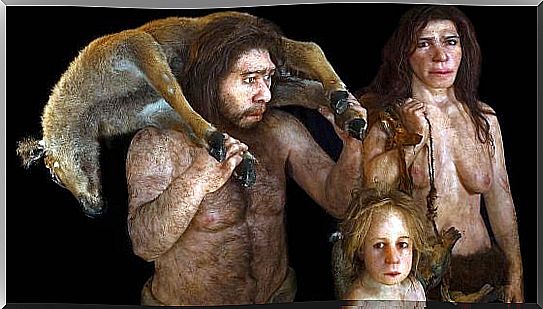The Brain Of The Neanderthals

Neanderthals ( Homo neanderthalensis ) are representatives of an extinct species of the genus Homo. They have lived with humans for a long time ( Homo Sapiens ). This was for most of the second half of the Pleistocene, between 230,000 and 28,000 years ago. They have spread to Europe, the Near and Middle East, as well as Central Asia.
Paleontological studies indicate that Neanderthals and humans have a common origin, so they share certain morphological traits and have similar cognitive abilities. In addition, there is also evidence that the two species have crossed each other throughout their history to give rise to hybrid descendants. This means that our human genome currently contains 2% Neanderthal genes.
We will see, in the rest of this article, what are the morphological characteristics of Neanderthals, focusing on their brain, and we will also explain how this could have influenced their extinction.
The morphology of Neanderthals
Anatomically, Neanderthals were stronger than Homo Sapiens , with larger chests and hips. Despite this sturdiness, they had shorter limbs. Their skull was characterized by its double brow bone, its narrow forehead, the absence of a chin and a slightly larger cranial capacity than in humans.
These cranial features give clues to what Neanderthals’ faces might have looked like : prominent nose, drooping cheekbones, and slightly protruding upper jaw. The prominent nose can be explained as an adaptive improvement to withstand the harsh glaciations of its time.

Neanderthals were omnivorous, just like humans. Depending on their habitat, they harvested a wide variety of food. They ate large mammals, fish, shellfish, but also vegetables and fruits recovered through harvesting.
On the other hand, anatomical studies of the remains found in Neanderthals provide clues to the possibility of articulate language. In addition, thanks to a multitude of excavations, it is known that they had a complex organizational capacity, venerated their dead, cared for their sick, made tools and even created art.
The brain of Neanderthals
The brains of Neanderthals were larger than that of human beings. In addition, their brain growth was also slower than ours. This is a very significant characteristic: it took them a lot of energy to keep such a large brain functioning. So they needed a lot of nutrients and care during childhood to ensure its development.
This means that, despite the difference in size, the brains of Neanderthals and humans have matured similarly. The growth pattern between the two species therefore had to be inherited by a common ancestor. This characteristic was very important for the adaptation of the human being, and now we know that it was also so for the Neanderthals. Indeed, a longer development time makes it possible to have a bigger brain and therefore better mental capacities.
This similarity between human and Neanderthal brain development was discovered through careful analysis of the remains of a Neanderthal infant found in the cave of El Sidrón, Asturias, which is 49,000 years old.
Another notable difference between the brains of Neanderthals and that of humans is shape. Our brain is proportionally spherical like a soccer ball, while that of the Neanderthals was more elongated, like a rugby ball. The consequences of this anatomical difference in the shape of the brain are still unknown.
Despite the large size of the Neanderthal brain, its cerebellum was smaller than that of humans. This little detail could have made a big difference between the two species. Indeed, the cerebellum is a very important part of the brain, because it regulates cognitive abilities, such as concentration, memorization and cognitive flexibility, as well as the understanding and production of language.
On the other hand, the occipital lobe of the Neanderthals was larger than that of the Homo Sapiens of the time. Neanderthals could therefore have had better visual abilities, because this region of the brain is responsible for processing the images we receive.
The explanation of the Neanderthal extinction
The extinction of the Neanderthals is one of the great mysteries of history. The most important factors are the expansion of Homo Sapiens in Eurasia and the gradual climate changes.
Analysis of Neanderthal remains found in several sites, from Russia to Spain, revealed that this Homo species became extinct 40,000 years ago. The Iberian Peninsula is the last known habitat of Neanderthals.
Some researchers believe that the brains of Neanderthals may have been one of the many reasons for their extinction. In particular his reduced cerebellum. Unlike Homo sapiens , Neanderthals had less cognitive and social abilities, so they did not adapt so easily to changes in the environment. Therefore, ancient humans had a better chance of survival. This is because of the larger size of their cerebellum.










